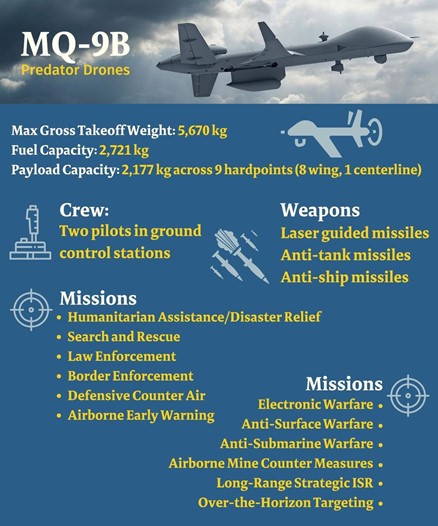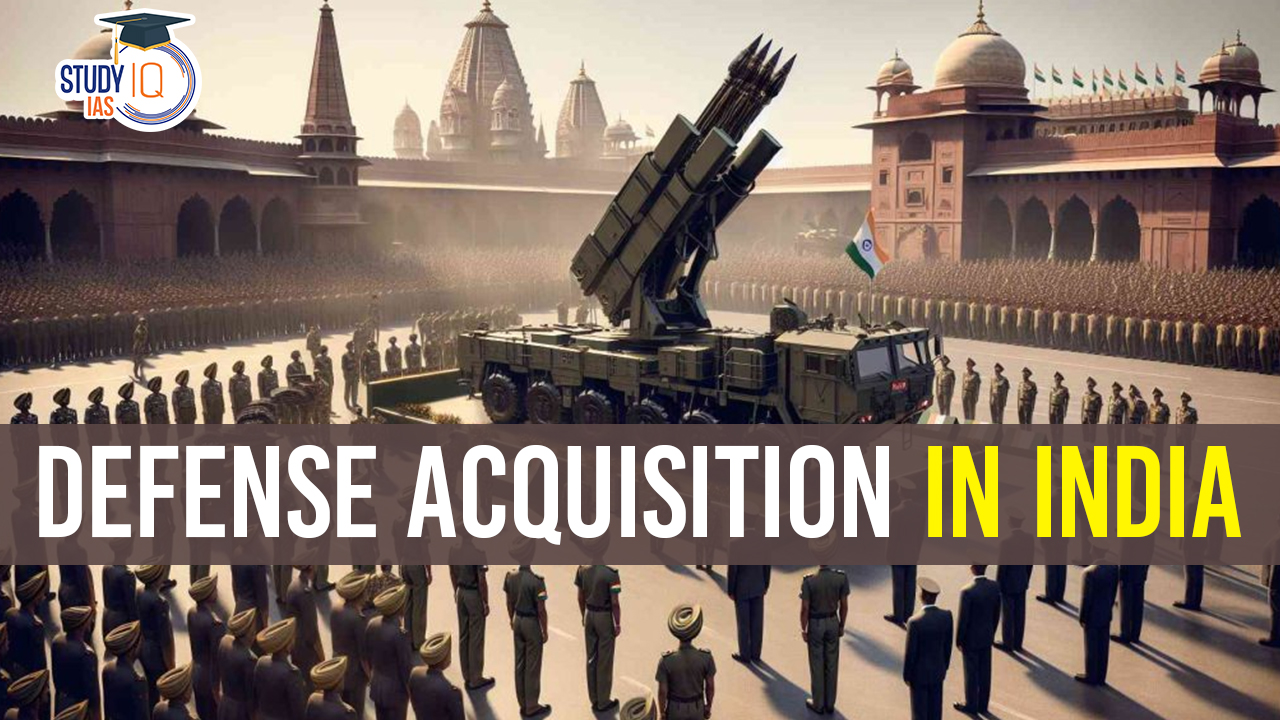Table of Contents
Context: Defence Acquisition Council reviewed and approved amendments to the procurement deal for 31 MQ-9B Unmanned Aerial Vehicles (UAVs) from General Atomics, USA.
More in News
- The amendments are primarily focused on increasing the indigenous content and other related aspects of the UAV deal.
- The deal involves procuring 31 MQ-9B UAVs—15 Sea Guardians for the Indian Navy and 16 Sky Guardians for the Indian Army and Air Force, with an estimated cost of $3.99 billion.
- General Atomics is also set to establish a Maintenance, Repair, and Overhaul (MRO) facility in India.

About Defence Acquisition Council in India
| Aspect | Details |
| What is it? | Highest decision-making body in the Ministry of Defence for procurement. |
| Chairman | Defence Minister. |
| Members | Chief of Defence Staff (CDS), Chiefs of Army, Navy, and Air Force. |
| Objective | To ensure expeditious procurement for the armed forces. |
| Formation |
|
| Functions |
|
What is Defence acquisition?
Defence acquisition, also known as military acquisition, is a comprehensive process involving the bureaucratic management and procurement of technologies, programs, and product support necessary for a nation’s national security strategy and the support of its armed forces. This extensive process includes several key aspects:
- Design and Engineering: The initial stages of defence acquisition involve designing and engineering the required defence equipment or technology.
- Construction and Testing: Following design and engineering, the next steps are the construction and rigorous testing of the defence equipment to ensure its effectiveness and reliability.
- Deployment and Sustainment: Once tested, the equipment is deployed for use by the armed forces. Sustainment involves maintaining the operational readiness and effectiveness of this equipment over time.
- Disposal: The process concludes with the responsible disposal of equipment or technology that is no longer in use or has become obsolete.
| Related Information |
| Defence procurement in India is at present governed by the Defense Procurement Procedure 2016 and the Defense Acquisition Procedure 2020. |
Why Defence Procurement Procedure (DPP)?
The Defence Procurement Procedure (DPP) is implemented to streamline and govern the process of procuring defence equipment and technology. The key reasons for its existence are:
- Transparency and Efficiency: DPP aims to ensure transparency, fairness, and efficiency in the defence procurement process.
- Self-Reliance: It encourages self-reliance through the indigenization of defence products.
- Global Best Practices: DPP integrates global best practices and standards in the procurement process.
- Strategic Partnerships: It promotes strategic partnerships between the Indian defence sector and global defence manufacturers.
- National Security: DPP is crucial for maintaining and enhancing India’s defence capabilities, thereby ensuring national security.
Challenges Associated With Defence Acquisition In India
- Policy, Structural, and Cultural Challenges: The Indian defence industry faces significant policy, structural, and cultural issues, struggling to deliver modern defence hardware. This affects India’s defence indigenization and production capabilities.
- Procedural Complexities: The defence acquisition process is hindered by procedural complexities due to a multi-stage acquisition cycle, inadequately defined processes, unrealistic Services Qualitative Requirements (SQRs), lack of expertise in areas like costing and commercial negotiations, and textual ambiguities in procurement manuals.
- Absence of a Comprehensive Security Policy Framework: The lack of a National Security Strategy hampers proper planning for capability development, although the armed forces continue to draw up acquisition plans based on the Raksha Mantri’s Operational Directives.
- Flawed Planning Process: The defence planning process is criticised for being non-inclusive, lacking an overarching professional organisation for comprehensive defence planning, and not considering financial viability.
- Loosely Structured Organisation: The organisation handling capital procurements, including the Defence Acquisition Council and Defence Procurement Board, suffers from a lack of cohesive and expeditious decision-making due to the dispersed administrative and financial powers.
- Funding Shortages: A persistent shortage of funds for the acquisition and sustenance of equipment has been a significant challenge, with a growing gap between the requirement projected by the armed forces and the budgetary allocation.
- Lack of Focus on Defence R&D: India’s low investment in defence R&D and researcher density has hindered the development of breakthrough military technology, making India one of the largest importers of military equipment globally.
Way Forward
- Increase in Defence Budget: There has been a significant increase in the defence budget, with a focus on acquisitions and modernization of the armed forces. This includes a 3% increase in the capital budget allocation for the armed forces.
- Foreign Direct Investment (FDI): The Indian government has allowed up to 49% FDI under the automatic route in defence manufacturing, engaging in agreements with key defence manufacturing countries like the United States, Israel, and Russia.
- Chief of Defence Staff (CDS) Role: The newly created position of CDS is intended to drive defence acquisition and modernization efforts, aiming to increase jointness between the services, prepare the military for changing security landscapes, and align them with India’s strategic goals.
- Integrated System and Theatre Commands: The creation of the CDS post is part of an effort to establish an integrated system that increases efficiency and responsiveness to threats. India is also aspiring to create theatre commands by 2022 for better coordination and effectiveness.
- Department of Military Affairs (DMA): The DMA, headed by the CDS, is responsible for administrative and revenue procurement matters and will play a key role in decision-making for modernization efforts and organisational matters.


 State Science and Technology Councils (S...
State Science and Technology Councils (S...
 Operation Shiva 2025: Indian Army’s Ma...
Operation Shiva 2025: Indian Army’s Ma...
 World Youth Skills Day 2025, Theme, Hist...
World Youth Skills Day 2025, Theme, Hist...





















